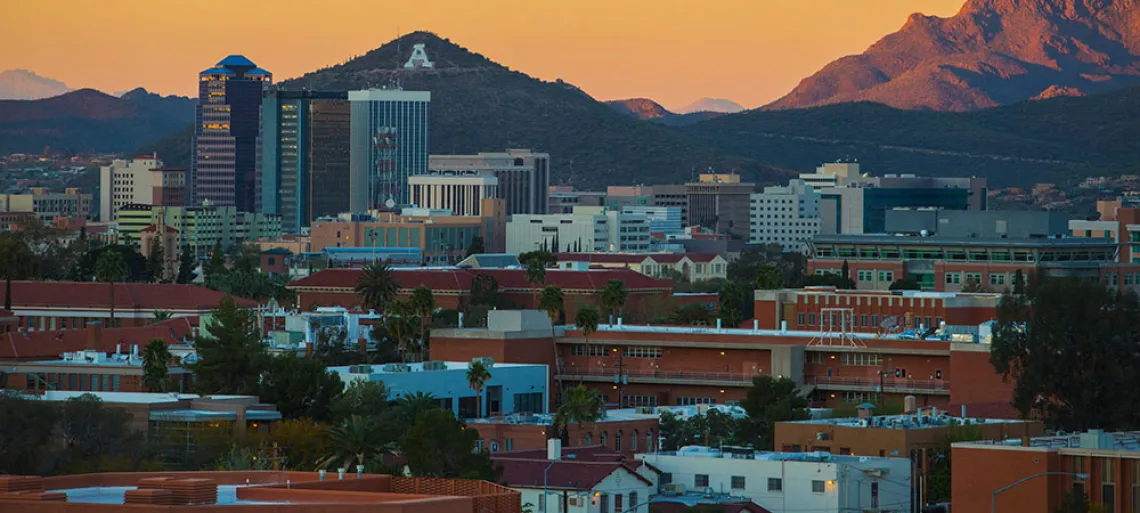Tucson Can Expect Solid Gains in Jobs, Population and Income Next Year
UA Eller Economist George Hammond and Federal Reserve Economist Jesus Cañas shared details at June 6 Breakfast with the Economists.

TUCSON, Ariz. – June 6, 2018 – Tucson’s formerly sluggish economy is expected to pick up modestly next year, with solid gains in jobs, population and income. While growth will be at a pace similar to the nation, it will continue at a slower rate than Phoenix and the state of Arizona. That was the key takeaway during today’s University of Arizona Eller College of Management 2018 Breakfast with the Economists event at Loews Ventana Canyon Resort in Tucson.
More than 350 people attended the event to hear presenters George W. Hammond, Ph.D., director and research professor at UA Eller’s Economic and Business Research Center, and Jesus Cañas, a senior business economist with the Federal Reserve Bank of Dallas, discuss local job growth, new home construction, population growth, federal procurement spending, rising interest rates, tax cuts, stock market volatility, controversial trade policies and other timely economic factors.
First on many people’s minds was the topic of jobs. Hammond reported that the Tucson MSA added 5,400 jobs last year, which translated into 1.5 percent growth. That was the fastest growth since 2012, which was also 1.5 percent, and nearly matched the national rate of 1.6 percent. However, Tucson’s job gains came at a slower rate than the Phoenix MSA, at 2.8 percent, and the state, at 2.4 percent.
“Tucson’s job growth during 2016 and 2017 was solid. That contrasts with the minimal gains posted during the 2013-2015 period, when Tucson was hit hard by reductions in federal procurement spending related to the federal sequester and other budget cuts,” Hammond said.
Federal procurement spending is defined as federal government purchases of goods and services from the private sector. Hammond shared that federal procurement spending in Arizona increased significantly during fiscal year 2016 and 2017, after major declines during the 2013-2015 period.
“In the first quarter of 2018, Tucson added 3,500 jobs over the year, for 0.9 percent growth. Most of those gains were concentrated in construction, education and health services, government, and manufacturing,” he said.
Strong construction job gains reflect a significant increase in Tucson housing permits last year, according to revised data from the U.S. Census Bureau. Tucson permits hit 4,495 last year, which was the highest level in 10 years. A major surge in multi-family permits fueled the increase, but single-family permits rose as well.
Tucson single-family house prices rose 7.9 percent over the year in the first quarter, according to data from the Federal Housing Finance Agency.
“That was faster that the national rate of 6.6 percent,” Hammond noted. “House prices are outpacing inflation and income growth. That means that housing affordability is declining. However, Tucson still ranks well in housing affordability compared to many peer western metropolitan areas, and affordability is still well above levels last seen at the house price peak.”
Hammond shared that Arizona’s merchandise exports to Mexico continued to decline last year, falling by an additional 8.6 percent.
“Exports to Mexico peaked in 2015 and declined by 17.3 percent during the next two years. However, there are some encouraging signs of stabilization in exports to Mexico in the data for the first quarter of 2018. Overall, the U.S. dollar remains elevated against the Mexican peso, which has likely put downward pressure on state exports,” he said.
Looking forward, Hammond said Tucson MSA can expect continued solid job gains during 2018 and 2019, if the U.S. avoids recession.
“Tucson is forecast to add 5,500 jobs this year and 6,000 in 2019, which translates into job growth of 1.5 percent and 1.6 percent, respectively,” he said, adding that job gains will contribute to population increases of 6,800 in 2018 and 6,900 next year.
“Job growth also supports solid wage and income gains, with personal income forecast to increase by 4.1 percent this year and 4.8 percent next year,” he said. “Also supporting income growth are legislated increases to the state minimum wage and increased funding for education.”
Cañas focused on the benefits and challenges of trade under NAFTA. Attendees learned how the U.S. and Mexico trade relationship helps them compete globally, and Cañas also discussed how border cities have progressed economically.
For more information, visit Eller’s Economic and Business Research website, view the Breakfast with the Economists 2018 presentation slides.

